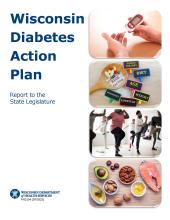The Wisconsin Diabetes Action Plan
In March 2020, Wisconsin signed the Diabetes Care and Prevention Action Program Act, Wis. Stat. § 255.085. The goal of this act is to assess the impact and reach of diabetes in Wisconsin. In response to this act, the Wisconsin Department of Health Services created the Wisconsin Diabetes Action Plan 2023: Report to the State Legislature, P-03154-2024 (PDF). This report also lists a range of actionable recommendations for consideration by the legislature. It is important to note that there are many things that private insurance companies, private employers and plan sponsors, and other partners can do to make these recommendations a reality. The goal of these recommendations is to reduce the number of new cases of diabetes, improve diabetes care, and manage issues with diabetes.
Recommendations to address diabetes
Below is an overview of the recommendations to address diabetes for consideration by the legislature. These recommendations focus on how changing systems, policies, and funding under legislative control can positively influence diabetes prevention and management.
Cost sharing refers to the patient's portion of costs (paid out of pocket) for health care services covered by their health insurance plan. Common types of cost sharing include copayment, deductibles, and coinsurance.
For people with diabetes, this includes the recurring costs of:
- Glucometers, including self-monitoring blood glucose and continuous glucose monitors
- Test strips, sensors
- Lancets
- Supplies to deliver insulin in the form of an injection, pump, or pod
- Emergency glucagon for severe low blood sugar or hypoglycemia
Cost of diabetes management medication is a large barrier for patients. The average list price of insulin tripled between 2002 and 2013 and doubled again from 2012 to 2016. According to a report by the CDC (Centers for Disease Control and Prevention), nearly a quarter of people with diabetes report asking their doctor for a cheaper medication, and one in 10 said they didn’t take insulin as prescribed because of cost. By clearly laying out costs and pricing for diabetes management medications, we can work to decrease the cost of these medications.
Source: American Diabetes Association. Economic Costs of Diabetes in the U.S. in 2017. Diabetes Care. 2018;41(5):917-928. doi:10.2337/dci18-0007
There are a couple of ways to expand access to CGM:
- By expanding CGM coverage across private and public marketplaces, and
- By expanding ForwardHealth’s CGM device and accessory coverage by replacing the prior authorization requirement with revised qualifying criteria.
- By continuing to expand broadband internet access throughout all parts of the state so people with diabetes can use Bluetooth and internet applications to share glucose data in a timely manner with their diabetes providers.
Expansion should include people under 21 years of age and anyone out of ideal blood glucose control ranges.
This includes:
- Considering RDNs and diabetes educators to be Medicaid billable providers. This may allow RDNs to collaborate with behavioral health and medical providers in the care of patients.
- Reimbursing Medical Nutrition Therapy (MNT) provided by RDNs.
2021 Wisconsin Act 98 gives pharmacists provider status for Medicaid services within their scope of practice, allowing reimbursement for this work. Adding RN, CDCES, and RDN to the list of providers and making sure the new pharmacist scope of work includes education will give them acknowledgement of the importance of education for community members in an environment that is convenient and safe for people with diabetes. In addition, allowing RDNs to supply Medical Nutrition Therapy (MNT) with reimbursement is needed. MNT addresses individual nutrition needs based on personal and cultural preferences, health literacy, access to healthy foods, willingness, and ability to make behavioral changes.
These educational services (DSMES, diabetes self-management training (DSMT), National DPP, and MNT) are team approaches to help keep Wisconsin’s communities safe and healthy. The services should be available via both in-person and telehealth/distance learning.
The expansion of telehealth in both rural and urban areas has increased overall access to health care. Including DSMES in the reimbursable services covered by telehealth in both rural and urban areas can increase the services' reach.
As described above, including pharmacists (PharmD), nurses (RNs), registered dietitian nutritionists (RDNs), and certified diabetes care and education specialists (CDCES) as reimbursable providers by telehealth is important as well.
Insulin is expensive, even for people with health insurance.
Besides insulin, there are a wide range of medications that can help manage diabetes, but not all health care insurance companies will cover them.
Policy change is needed to expand medications covered by health care insurance plans to ensure people can afford to treat their diabetes.
CHWs can reach a wide variety of communities and provide a number of health care services.
CHWs work with community, local, and state agencies to build trusting relationships with community members for individual care coordination and community education and outreach. However, Wisconsin CHWs are not currently a reimbursable provider type and therefore, services that CHWs provide to community members are not covered under Wisconsin health care insurance companies, including Medicaid.
In addition to including CHWs as a covered provider type, policy change is needed to recognize a CHW scope of practice and ensure professional development standards.
Under the Affordable Care Act all preventative services must be covered by health care insurance providers. By listing the National Diabetes Prevention Program and diabetes self-management education and support services as preventive services, these costs can be covered by insurance health care plans.
To gain community input on these recommendations, the Chronic Disease Prevention Program surveyed community members on the impact of diabetes. To learn more about the survey, visit the Wisconsin Diabetes Action Plan Survey.
If you have any questions, comments, or additional information to share, email the Chronic Disease Prevention Program at DHSChronicDiseasePrevention@dhs.wisconsin.gov.

